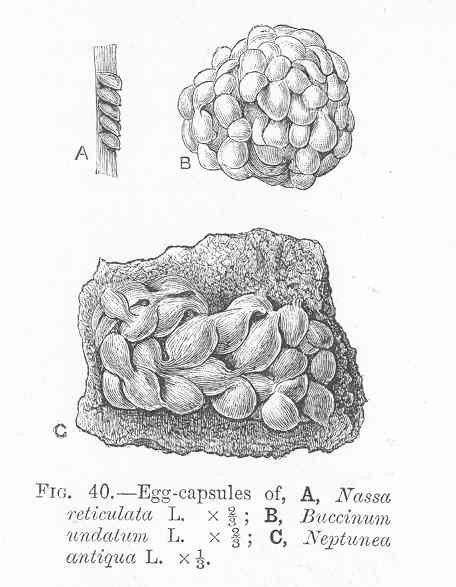|
Egg capsules: Tritia reticulata (netted dog whelk), Buccinum undatum (common whelk), Neptunea antiqua (red whelk)
| 제목: | Egg capsules: Tritia reticulata (netted dog whelk), Buccinum undatum (common whelk), Neptunea antiqua (red whelk)
| | 올린이: | Wiki Photos (---@---.---)
| |

| 해상도: 456x587
파일크기: 49177 Bytes
등록시간: 2024:01:10 09:08:11
|
Fig. 40. -- Egg-capsules of
A, Nassa reticulata L. ( = Tritia reticulata (netted dog whelk) );
B, Buccinum undalutum L. ( = Buccinum undatum (common whelk) );
C, Neptunea antiqua L. ( = - (red whelk) )
Subject: Nassa, Buccinum, Neptunea
Tag: Mollusks
Date 1895
Author A. H. Cooke (Alfred Hands Cooke, 1845–1904); Arthur Shipley (1861–1927); Frederick R. C. Reed (Frederick Richard Cowper Reed, 1869–1946)
Source/Photographer English: Cooke, A. H.; Shipley, A. E.; Reed, F. R. C. (1895) Molluscs, Cambridge Natural History, v.3, London: Macmillan and Co.
Source: https://commons.wikimedia.org/wiki/File%3AFMIB_48545_Egg-capsules_of_A%2C_Nassa_reticulata_L%3B_B%2C_Buccinum_undalutum_L%3B_C%2C_Neptunea_antiqua_L.jpeg
A. Nassa reticulata = Tritia reticulata (netted dog whelk)
The netted dog whelk (Tritia reticulata) is a species of small European sea snail in the family Nassariidae. It has a pointed, straight-sided spire and a creamy-brown shell that can grow up to 3 cm in height. The surface of the shell is deeply chequered by longitudinal folds, crossed by numerous striae, giving it a characteristic netted (reticulate) pattern. The outer lip of the aperture is thickened and toothed in mature animals.
B. Buccinum undalutum = Buccinum undatum (common whelk)
The common whelk or waved buccinum (Buccinum undatum) is a large, edible marine gastropod in the family Buccinidae found in the Northern Atlantic. It is commonly found on the shores of the United Kingdom, Ireland, France, Norway, Iceland, some Arctic islands, and parts of North America as far south as New Jersey. The shell of the common whelk is ovate-conical and ventricose, with a height of up to 10 cm and a width of up to 6 cm. The spire contains seven or eight whorls, which are convex and crossed by oblique folds, thick and waved. The shell surface has a sculpture of vertical, wavy folds (hence the name undatum, which means wavy). The white and very large aperture of the shell is broadly oval and tapers to a deeply notched siphonal canal. The outer lip is arched.
C. Neptunea antiqua (red whelk)
The red whelk (Neptunea antiqua) is a species of Northeast Atlantic sea snail in the family Buccinidae. It is a tall spired whelk with 7 or 8 whorls, and can grow up to 20 cm in length, although most specimens only reach half that size. The body whorl comprises about ¾ of the total height and the whorls are slightly convex, giving a stepped effect and ornamented with fine ridges following the spirals. |
^o^
동물그림창고 똑똑전화 누리집
^o^
|
|